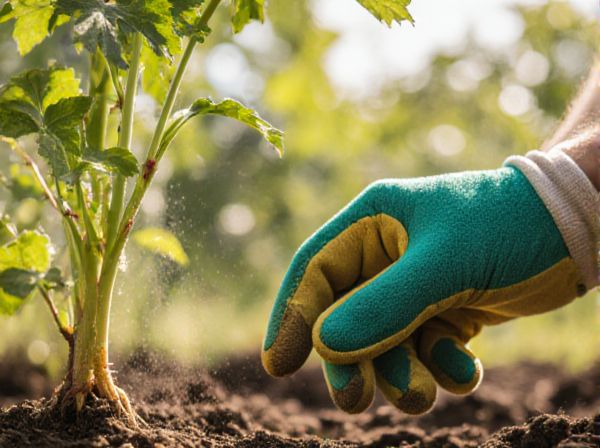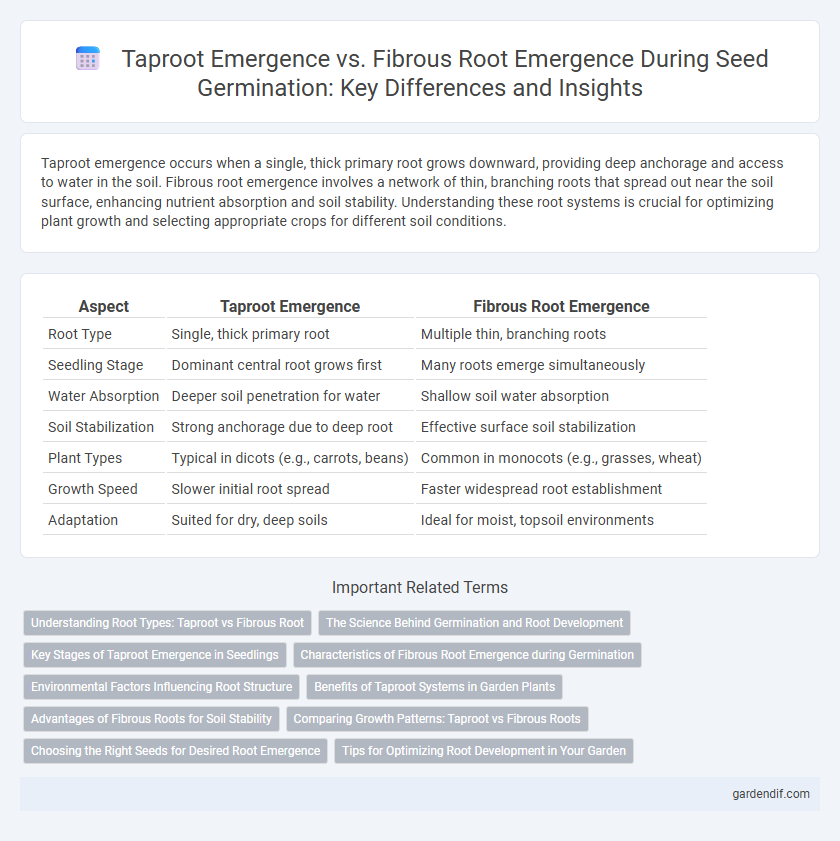
Taproot Emergence vs Fibrous Root Emergence Illustration
Taproot emergence occurs when a single, thick primary root grows downward, providing deep anchorage and access to water in the soil. Fibrous root emergence involves a network of thin, branching roots that spread out near the soil surface, enhancing nutrient absorption and soil stability. Understanding these root systems is crucial for optimizing plant growth and selecting appropriate crops for different soil conditions.
Table of Comparison
| Aspect | Taproot Emergence | Fibrous Root Emergence |
|---|---|---|
| Root Type | Single, thick primary root | Multiple thin, branching roots |
| Seedling Stage | Dominant central root grows first | Many roots emerge simultaneously |
| Water Absorption | Deeper soil penetration for water | Shallow soil water absorption |
| Soil Stabilization | Strong anchorage due to deep root | Effective surface soil stabilization |
| Plant Types | Typical in dicots (e.g., carrots, beans) | Common in monocots (e.g., grasses, wheat) |
| Growth Speed | Slower initial root spread | Faster widespread root establishment |
| Adaptation | Suited for dry, deep soils | Ideal for moist, topsoil environments |
Understanding Root Types: Taproot vs Fibrous Root
Taproot emergence features a primary root that grows vertically downward, allowing deep soil penetration for enhanced water and nutrient access, commonly seen in dicotyledonous plants like carrots and dandelions. Fibrous root emergence consists of a network of thin, branching roots spreading horizontally near the soil surface, providing increased soil stabilization and efficient nutrient absorption in monocots such as grasses and wheat. Understanding these root types is crucial for optimizing agricultural practices, as taproots improve drought resistance while fibrous roots enhance soil erosion control.
The Science Behind Germination and Root Development
Taproot emergence involves a primary root growing downward to anchor the seedling and absorb deep water and nutrients, driven by cell elongation and hormonal signals like auxins. In contrast, fibrous root emergence produces a network of thin roots from the base of the stem, enhancing surface area for nutrient uptake and soil stabilization through rapid cell division in the root apical meristem. Both root systems reflect distinct genetic expression patterns and environmental responses critical to successful germination and seedling establishment.
Key Stages of Taproot Emergence in Seedlings
Taproot emergence marks a critical initial phase in seedling development, beginning with radicle protrusion from the seed coat, followed by rapid elongation into the soil to anchor the plant and absorb water. As the taproot grows, secondary roots start forming from the primary root, enhancing nutrient uptake and stability. These key stages ensure efficient establishment and support the seedling's transition from germination to early growth.
Characteristics of Fibrous Root Emergence during Germination
Fibrous root emergence during germination is characterized by the development of a dense network of thin, branching roots that spread out widely just below the soil surface. These roots lack a dominant central root, enabling rapid absorption of water and nutrients from the upper soil layers. This type of root system enhances soil stabilization and supports efficient resource uptake in grasses and monocot plants.
Environmental Factors Influencing Root Structure
Soil type, moisture levels, and nutrient availability play crucial roles in determining whether a taproot or fibrous root system develops during germination. Sandy soils with low water retention often promote fibrous root emergence for better surface absorption, whereas clay or loamy soils rich in nutrients favor taproot development for deeper anchorage and resource access. Temperature fluctuations and oxygen concentration in the soil further influence root morphology, affecting the adaptability and survival rate of seedlings.
Benefits of Taproot Systems in Garden Plants
Taproot systems in garden plants enhance deep soil penetration, allowing efficient water and nutrient absorption from lower soil layers. This robust root structure provides superior anchorage, improving plant stability and resistance to drought conditions. Taproots also facilitate long-term storage of nutrients, supporting sustained growth and resilience in perennial species.
Advantages of Fibrous Roots for Soil Stability
Fibrous root systems offer superior soil stability by forming dense, interwoven networks that prevent erosion and enhance nutrient retention. Unlike taproot systems, fibrous roots spread widely and uniformly, anchoring the soil more effectively against water runoff and wind displacement. These characteristics make fibrous root emergence particularly advantageous for maintaining soil structure and supporting sustainable plant growth in erosion-prone environments.
Comparing Growth Patterns: Taproot vs Fibrous Roots
Taproot emergence features a dominant central root growing downward, providing deep soil anchorage and access to water reserves, ideal for drought resistance. In contrast, fibrous roots develop as a dense network of thin, branching roots spreading horizontally near the soil surface, enhancing nutrient absorption and soil erosion control. These distinct growth patterns influence plant stability, resource uptake, and adaptation to environmental conditions.
Choosing the Right Seeds for Desired Root Emergence
Selecting seeds based on desired root system significantly impacts plant stability and nutrient uptake. Taproot emergence, common in dicots like carrots and radishes, promotes deep soil penetration for water access and anchorage. Fibrous root emergence, typical in monocots such as grasses and wheat, creates a dense network for surface soil nutrient absorption and erosion control.
Tips for Optimizing Root Development in Your Garden
Promote taproot emergence by ensuring deep, loose soil to allow strong, downward growth essential for plants like carrots and beans. For fibrous root systems typical of grasses and lettuce, maintain consistent moisture and moderate soil compaction to encourage spreading roots that increase nutrient absorption. Incorporate organic matter and avoid excessive fertilization to balance root development and enhance overall plant stability.
Taproot Emergence vs Fibrous Root Emergence Infographic

 gardendif.com
gardendif.com